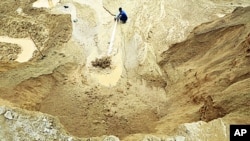An announcement this week by China that it plans to cut export quotas for rare earth minerals next year is raising concerns about future supplies of the increasingly sought after natural resource that is a crucial component in a wide range of high-tech goods. The move is sparking trade concerns and helping boost the hunt for and production of rare earths outside of China.
Right now, about 97 percent of the world's production of rare earth minerals is located in China.
So, when China announced this week that it was cutting its quotas for the export of rare earths, countries and companies that rely on the elements for the production of everything from high-tech electronic devices to electric cars, wind turbines and defense systems began voicing objections.
Japan's electronics giant Sony says the move is a hindrance to free trade and says it will try to reduce its reliance on Chinese supplies.
U.S. representatives at the World Trade Organization say they're "very concerned" about the restraints and have raised the issue with China. The U.S. says it may complain to the WTO about China's export restraints.
China argues that its export controls are in line with World Trade Organization rules.
Foreign Ministry spokeswoman Jiang Yu says the measures are necessary to protect China's environment and supply of resources. She adds that in the future China will continue to provide rare earth products to the international market.
Concern over the export of rare earth minerals has been building in recent months.
China slashed export quotas for the minerals in the second half of 2010, citing a shortage of supply for domestic manufacturers. And, when it was embroiled in a diplomatic dispute with Tokyo, shipments of the minerals to Japan were temporarily interrupted.
|
Listen to the extended interview with Gabe Collins
|
Gabe Collins, the co-founder of China www.chinasignpost.com, a Web site that focuses on China research and analysis, says that he does not believe China will let the issue cause too much unnecessary friction in its relations with other countries.
But, he adds that if there is some dispute again with Japan, the rare earths issue could come up again. China and Japan are the two major rare earth component producers in the world.
China's moves to cut quotas, Collins says, are ultimately reflection of its industrial policy.
"What they are trying to do. There is two things," said Collins. "One, is you're seeing more and more electronics manufacturing in China, that's keeping rare earths at home by itself. The second thing is you're seeing, this is a manifestation of a Chinese industrial development policy. Namely, they want to keep they want to keep the higher value added steps of the manufacturing chain in China."
In a recent China SignPost report on China's rare earth minerals and the debate it is sparking, Collins suggests that the U.S. start building up a strategic reserve of the minerals. He also says the U.S. and other governments should discuss the issue with China at high-level meetings.
"Given the strategic nature of these elements. How critical they are both to defense applications and a lot of the commercial applications, I think this would certainly be a subject that would be very much worth putting on the agenda for example in the Strategic and Economic Dialogue with China, perhaps some of the WTO discussions between members of the European Union, China, Japan and the United States."
While the decision is raising concerns from governments, it is giving companies outside of China that are already in the business of mining rare earth minerals or working to restart projects a big boost.
Companies such as Australia's Lynas Corporation and the U.S.-based Molycorp have seen their share prices shoot up since the decision was announced.
Molycorp resumed operation of its rare earth metal facility in California last week. The site was shut down in 2002 amid environmental concerns and low costs for rare earth metals from mines in China.
The U.S. state of Alaska and others are actively assessing the prospects for the mining of rare earths.
Bob Swenson is the director of Alaska's division of geological and geophysical surveys.
"The Bokan area is actually the only known minable occurrence of rare earth elements in Alaska. We do have many areas specifically in interior Alaska as well as down in southeast Alaska where we do have indications of permissible geology for rare earths and those are the areas we've really been focusing on," he said.
In November, the U.S. Geological Survey carried out its first-ever assessment for rare earths and found that deposits that total about 13 million metric tons had been found in 14 states.
World demand for rare earths is currently at about 120,000 metric tons per year, with China accounting for most of that demand. The remainder is split between Japan, the United States and Europe.











